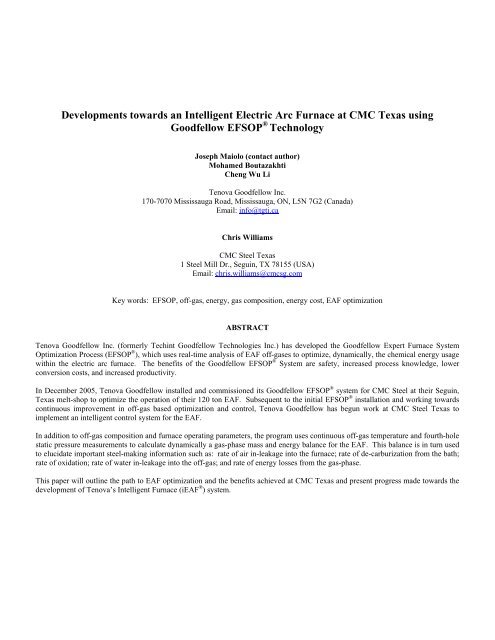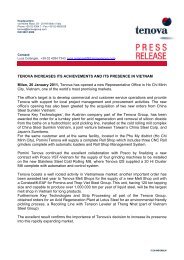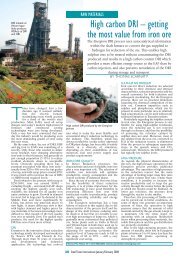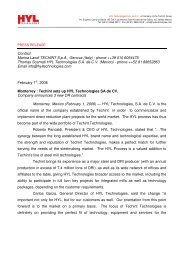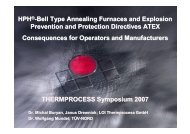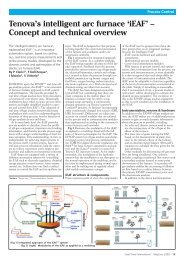Developments Toward an Intelligent Electric Arc Furnace at - Tenova
Developments Toward an Intelligent Electric Arc Furnace at - Tenova
Developments Toward an Intelligent Electric Arc Furnace at - Tenova
Create successful ePaper yourself
Turn your PDF publications into a flip-book with our unique Google optimized e-Paper software.
<strong>Developments</strong> towards <strong>an</strong> <strong>Intelligent</strong> <strong>Electric</strong> <strong>Arc</strong> <strong>Furnace</strong> <strong>at</strong> CMC Texas using<br />
Goodfellow EFSOP ® Technology<br />
Joseph Maiolo (contact author)<br />
Mohamed Boutazakhti<br />
Cheng Wu Li<br />
<strong>Tenova</strong> Goodfellow Inc.<br />
170-7070 Mississauga Road, Mississauga, ON, L5N 7G2 (C<strong>an</strong>ada)<br />
Email: info@tgti.ca<br />
Chris Williams<br />
CMC Steel Texas<br />
1 Steel Mill Dr., Seguin, TX 78155 (USA)<br />
Email: chris.williams@cmcsg.com<br />
Key words: EFSOP, off-gas, energy, gas composition, energy cost, EAF optimiz<strong>at</strong>ion<br />
ABSTRACT<br />
<strong>Tenova</strong> Goodfellow Inc. (formerly Techint Goodfellow Technologies Inc.) has developed the Goodfellow Expert <strong>Furnace</strong> System<br />
Optimiz<strong>at</strong>ion Process (EFSOP ® ), which uses real-time <strong>an</strong>alysis of EAF off-gases to optimize, dynamically, the chemical energy usage<br />
within the electric arc furnace. The benefits of the Goodfellow EFSOP ® System are safety, increased process knowledge, lower<br />
conversion costs, <strong>an</strong>d increased productivity.<br />
In December 2005, <strong>Tenova</strong> Goodfellow installed <strong>an</strong>d commissioned its Goodfellow EFSOP ® system for CMC Steel <strong>at</strong> their Seguin,<br />
Texas melt-shop to optimize the oper<strong>at</strong>ion of their 120 ton EAF. Subsequent to the initial EFSOP ® install<strong>at</strong>ion <strong>an</strong>d working towards<br />
continuous improvement in off-gas based optimiz<strong>at</strong>ion <strong>an</strong>d control, <strong>Tenova</strong> Goodfellow has begun work <strong>at</strong> CMC Steel Texas to<br />
implement <strong>an</strong> intelligent control system for the EAF.<br />
In addition to off-gas composition <strong>an</strong>d furnace oper<strong>at</strong>ing parameters, the program uses continuous off-gas temper<strong>at</strong>ure <strong>an</strong>d fourth-hole<br />
st<strong>at</strong>ic pressure measurements to calcul<strong>at</strong>e dynamically a gas-phase mass <strong>an</strong>d energy bal<strong>an</strong>ce for the EAF. This bal<strong>an</strong>ce is in turn used<br />
to elucid<strong>at</strong>e import<strong>an</strong>t steel-making inform<strong>at</strong>ion such as: r<strong>at</strong>e of air in-leakage into the furnace; r<strong>at</strong>e of de-carburiz<strong>at</strong>ion from the b<strong>at</strong>h;<br />
r<strong>at</strong>e of oxid<strong>at</strong>ion; r<strong>at</strong>e of w<strong>at</strong>er in-leakage into the off-gas; <strong>an</strong>d r<strong>at</strong>e of energy losses from the gas-phase.<br />
This paper will outline the p<strong>at</strong>h to EAF optimiz<strong>at</strong>ion <strong>an</strong>d the benefits achieved <strong>at</strong> CMC Texas <strong>an</strong>d present progress made towards the<br />
development of <strong>Tenova</strong>’s <strong>Intelligent</strong> <strong>Furnace</strong> (iEAF ® ) system.
OVERVIEW<br />
The CMC Texas EAF is a 22’ diameter EAF, 120 short ton eccentric bottom tapping, AC furnace powered by <strong>an</strong> 80 MVA<br />
tr<strong>an</strong>sformer. Chemical energy is provided by three PTI JetBox modules, three 3.5 MW burners (for carbon, oxygen <strong>an</strong>d meth<strong>an</strong>e) <strong>an</strong>d<br />
one 1 MW EBT conventional burner.<br />
The Goodfellow Expert <strong>Furnace</strong> System Optimiz<strong>at</strong>ion Process (Goodfellow EFSOP ® ) is a dynamic control <strong>an</strong>d optimiz<strong>at</strong>ion system<br />
for electric arc steelmaking furnaces (EAF) based on real-time measurements of off-gas composition. The system uses st<strong>at</strong>e-of-the-art<br />
off-gas <strong>an</strong>alysis combined with process d<strong>at</strong>a acquisition <strong>an</strong>d real-time closed loop control to optimize the oper<strong>at</strong>ion of the EAF.<br />
Typically, the objectives for optimizing the EAF oper<strong>at</strong>ion are to reduce conversion costs (energy <strong>an</strong>d m<strong>at</strong>erial), increase production<br />
<strong>an</strong>d improve safety.<br />
A schem<strong>at</strong>ic of the EFSOP ® system is shown in Figure 1. It includes the following components:<br />
• A w<strong>at</strong>er-cooled sampling probe<br />
• Gas <strong>an</strong>alysis system<br />
• Supervisory Control <strong>an</strong>d D<strong>at</strong>a Acquisition (SCADA) system<br />
Figure 1: Schem<strong>at</strong>ic of the EFSOP ® System
A p<strong>at</strong>ented, w<strong>at</strong>er-cooled sampling probe, custom designed for use in the harsh environment of the EAF, is installed through a port in<br />
the w<strong>at</strong>er-cooled ductwork, <strong>at</strong> the entr<strong>an</strong>ce to the fixed duct <strong>an</strong>d after the combustion gap. The loc<strong>at</strong>ion <strong>an</strong>d positioning of the probe is<br />
such th<strong>at</strong> the gases are sampled before introduction of combustion air from the gap <strong>an</strong>d so are represent<strong>at</strong>ive of the composition of<br />
gases in the freeboard of the furnace. The extracted gases are tr<strong>an</strong>sported via a he<strong>at</strong>ed sample line to the EFSOP ® gas <strong>an</strong>alysis system<br />
where the continuous stream of sampled gases are <strong>an</strong>alyzed for oxygen (O2), carbon dioxide (CO2), carbon monoxide (CO), <strong>an</strong>d<br />
hydrogen (H2).<br />
A secondary function of the <strong>an</strong>alyzer unit is to periodically back-purge the sampling line <strong>an</strong>d probe to remove accretions inside the<br />
probe <strong>an</strong>d dust build-up from the various internal filters employed. The system is only purged during n<strong>at</strong>ural breaks in the process<br />
(e.g. during charging, tapping or other power-off times) so as to ensure reliable <strong>an</strong>d continuous off-gas composition measurements.<br />
Composition measurements, as well as oper<strong>at</strong>ional alarms <strong>an</strong>d outputs from the <strong>an</strong>alyzer are sent to the pl<strong>an</strong>t’s PLC network. The<br />
EFSOP ® HMI is linked to the same network. The Hum<strong>an</strong>-Machine Interface (HMI) reads <strong>an</strong>d logs the off-gas d<strong>at</strong>a, as well as all<br />
relev<strong>an</strong>t process d<strong>at</strong>a <strong>at</strong> a frequency of 1 second. In total over 200 furnace parameters are sampled <strong>an</strong>d logged. Both historical <strong>an</strong>d<br />
real-time plots of the d<strong>at</strong>a are available. In addition to real time process d<strong>at</strong>a trending <strong>an</strong>d historical d<strong>at</strong>a mining, the HMI allows<br />
regular d<strong>at</strong>a tr<strong>an</strong>sfer to TGTI’s office in Mississauga. The EFSOP ® SCADA system consists of a high-speed computer <strong>an</strong>d GE’s iFIX<br />
SCADA software. Furthermore, the SCADA system performs control calcul<strong>at</strong>ions, in response to furnace off-gas d<strong>at</strong>a <strong>an</strong>d sends<br />
oxygen <strong>an</strong>d meth<strong>an</strong>e flow setpoints PLC.<br />
EAF Optimiz<strong>at</strong>ion<br />
<strong>Furnace</strong> optimiz<strong>at</strong>ion via EFSOP ® , typically, follows two parallel p<strong>at</strong>hs: 1) closed-loop control of chemical energy <strong>an</strong>d postcombustion<br />
(oxygen, meth<strong>an</strong>e <strong>an</strong>d carbon r<strong>at</strong>es) in response to off-gas composition measurements <strong>an</strong>d 2) adjustments to the EAF<br />
process from off-line <strong>an</strong>alysis of furnace oper<strong>at</strong>ion using a variety of proprietary tools such as adv<strong>an</strong>ced regression methods; <strong>an</strong>d<br />
TGTI’s DECSIM electric arc furnace modeling software ([1] <strong>an</strong>d [2]).<br />
The first is the implement<strong>at</strong>ion dynamic control of post-combustion in the furnace freeboard in response to off-gas composition while<br />
working within the mech<strong>an</strong>ical limit<strong>at</strong>ions of the existing hardware. During periods when the furnace off-gas is reducing, additional<br />
oxygen may be added or meth<strong>an</strong>e flow reduced; altern<strong>at</strong>ively, during periods when the furnace off-gas is oxidizing, oxygen flow<br />
maybe reduced <strong>an</strong>d/or meth<strong>an</strong>e increased. The challenge is to maintain a slightly reducing <strong>at</strong>mosphere in the furnace freeboard. In<br />
practice, the implement<strong>at</strong>ion of closed-loop control requires th<strong>at</strong> constraints be placed flow set-points of oxygen/meth<strong>an</strong>e <strong>at</strong> different<br />
stages of the he<strong>at</strong>. For example: directly after charging the flows may be limited so th<strong>at</strong> the flame does impinge on the scrap <strong>an</strong>d<br />
rebound back onto the p<strong>an</strong>el; during melting the flows are constrained so th<strong>at</strong> the injectors oper<strong>at</strong>e around stoichiometric or slightly<br />
super-stoichiometric; <strong>an</strong>d during refining, where supersonic oxygen flow is required, the constraints on oxygen flow are increased.<br />
The oper<strong>at</strong>ing profiles for oxygen <strong>an</strong>d meth<strong>an</strong>e delivery, definition of constraints <strong>an</strong>d timing as well as the ability to save different<br />
programs are possible through customized screens developed within the EFSOP ® HMI.<br />
The second aspect of optimiz<strong>at</strong>ion via the EFSOP ® system is in the form of process adjustments (e.g. timing <strong>an</strong>d intensity of oxygen<br />
l<strong>an</strong>cing, carbon injection, lime practice, fume system parameters, etc.). A holistic approach to optimiz<strong>at</strong>ion is taken <strong>an</strong>d adjustments<br />
to the process are made according to wh<strong>at</strong> is observed in the off-gas. To aid in this process, the EFSOP ® system includes proprietary<br />
software th<strong>at</strong> forwards oper<strong>at</strong>ing d<strong>at</strong>a directly to TGTI (on a daily basis). This d<strong>at</strong>a includes not only dynamic oper<strong>at</strong>ional inform<strong>at</strong>ion<br />
from the process, but also alarms <strong>an</strong>d oper<strong>at</strong>ing st<strong>at</strong>us of the EFSOP ® <strong>an</strong>alyzer. Any oper<strong>at</strong>ional issues with the EFSOP ® <strong>an</strong>alyzer are<br />
known directly <strong>an</strong>d c<strong>an</strong> be addressed quickly by feedback to the pl<strong>an</strong>t personnel. During the optimiz<strong>at</strong>ion stage of the EFSOP ®<br />
implement<strong>at</strong>ion, TGTI engineers are able to follow pl<strong>an</strong>t perform<strong>an</strong>ce remotely <strong>an</strong>d communic<strong>at</strong>e adjustments to the pl<strong>an</strong>t.<br />
The EFSOP ® system (probe, <strong>an</strong>alyzer <strong>an</strong>d SCADA system) was installed <strong>at</strong> CMC Texas in December, 2005. Preliminary<br />
observ<strong>at</strong>ions of off-gas composition revealed th<strong>at</strong> CMC’s oper<strong>at</strong>ion resulted in a signific<strong>an</strong>tly reducing furnace off-gas with rel<strong>at</strong>ively<br />
high levels of hydrogen <strong>an</strong>d carbon monoxide <strong>an</strong>d th<strong>at</strong> there was the opportunity to improve the practice by reducing the amount of<br />
chemical energy usage in the furnace. A different approach would have been taken if the process was determined to be oxidizing. An<br />
example off-gas profile before optimiz<strong>at</strong>ion is included (see Figure 3). The profile shows th<strong>at</strong> carbon monoxide concentr<strong>at</strong>ion (before<br />
optimiz<strong>at</strong>ion) was typically in the r<strong>an</strong>ge of 20%-30%, during melting, <strong>an</strong>d 30%-40% during refining.<br />
The noted observ<strong>at</strong>ion was typical during the preliminary d<strong>at</strong>a collections <strong>an</strong>d monitoring period th<strong>at</strong> extended into J<strong>an</strong>uary <strong>an</strong>d part<br />
of February of 2006. A str<strong>at</strong>egy for optimiz<strong>at</strong>ion was developed over th<strong>at</strong> period <strong>an</strong>d implemented during the l<strong>at</strong>er part of February<br />
2006. Using CMC’s typical burner <strong>an</strong>d power programs as a starting point, the following adjustments were made to the process:<br />
• Carbon injection was reduced during the melting stages of the process;<br />
• Closed-loop control was implemented to autom<strong>at</strong>ically adjust the stoichiometric r<strong>at</strong>io of oxygen to meth<strong>an</strong>e in response to<br />
off-gas composition measurements provided by the EFSOP ® system; <strong>an</strong>d
• The timing <strong>an</strong>d intensity of the fixed wall injectors was adjusted to control carbon evolution during the refining period.<br />
The EFSOP ® burner control program was customized over the course of the implement<strong>at</strong>ion period. Constraints on post-combustion,<br />
carbon injection <strong>an</strong>d the timing <strong>an</strong>d intensity of oxygen injection during refining were adjusted. To provide flexibility, the power-ontime<br />
period was divided into 12 stages th<strong>at</strong> are cycled through according to a kWh/ton electrical energy clock. Each burner, during<br />
each of these stages, is able to oper<strong>at</strong>e in one of twelve modes (eight burner modes <strong>an</strong>d four l<strong>an</strong>ce modes). Constraints on each mode<br />
included a minimum <strong>an</strong>d maximum r<strong>at</strong>e for oxygen <strong>an</strong>d meth<strong>an</strong>e within which the control program is free to modul<strong>at</strong>e. A default<br />
setting for each mode is also specified. The default is used in as a fail-safe in case the EFSOP ® system is unable to read accur<strong>at</strong>e offgas<br />
composition or in case the pl<strong>an</strong>t chooses to disable closed-loop control.<br />
The main principles in defining max <strong>an</strong>d min post-combustion modes are based on combustion chemistry. Optimiz<strong>at</strong>ion of<br />
combustion during periods of reducing chemistry requires th<strong>at</strong> more oxygen is added to provide additional energy for combustion.<br />
Meth<strong>an</strong>e may be reduced because there is already sufficient fuel in the off-gas <strong>an</strong>d additional meth<strong>an</strong>e is not needed. Conversely,<br />
during oxidizing periods, <strong>an</strong> excess amount of oxygen is present <strong>an</strong>d insufficient fuel. Therefore oxygen usage is reduced during these<br />
periods as it is not needed. There is overall less n<strong>at</strong>ural gas <strong>an</strong>d higher oxygen to meth<strong>an</strong>e r<strong>at</strong>ios in the EFSOP ® burner mode for the<br />
optimized practice th<strong>an</strong> the pl<strong>an</strong>t original practice because CMC Steel Tx’s furnace was observed to be highly reducing.<br />
Figure 2: The EFSOP ® Hum<strong>an</strong>-Machine Interface
Figure 3: Sample He<strong>at</strong> Chemistry<br />
W<strong>at</strong>er-Leak Detection<br />
In addition to the st<strong>an</strong>dard furnace optimiz<strong>at</strong>ion package, the install<strong>at</strong>ion of EFSOP ® <strong>at</strong> CMC Steel Tx included a w<strong>at</strong>er-leak detection<br />
routine. TGTI engineers have noted th<strong>at</strong> the presence of w<strong>at</strong>er in the EAF off-gas (through p<strong>an</strong>el leaks, excessive electrode cooling<br />
flow, wet scrap, etc.) affect the level of hydrogen in the off-gas sample; <strong>an</strong>d so even though w<strong>at</strong>er concentr<strong>at</strong>ion is not measurable<br />
directly (gases are <strong>an</strong>alyzed on a dry basis) the presence of w<strong>at</strong>er is detectible through hydrogen <strong>an</strong>d carbon monoxide levels. Based<br />
on this, a w<strong>at</strong>er-leak alarming system was implemented th<strong>at</strong> warns the oper<strong>at</strong>or of the possibility th<strong>at</strong> w<strong>at</strong>er is leaking into the furnace.<br />
It has been determined th<strong>at</strong> not only is the absolute value of hydrogen concentr<strong>at</strong>ion import<strong>an</strong>t but so is the rel<strong>at</strong>ionship between<br />
hydrogen <strong>an</strong>d carbon monoxide. It has also been observed th<strong>at</strong> absolute value of hydrogen concentr<strong>at</strong>ion <strong>an</strong>d the H2/CO r<strong>at</strong>io will<br />
vary over the course of the he<strong>at</strong>. This makes sense from a process point of view as things like the flashing of oils from the scrap<br />
<strong>an</strong>d/or wet scrap will affect hydrogen <strong>an</strong>d H2/CO r<strong>at</strong>io but do not constitute w<strong>at</strong>er-leaks. In order to account for these affects <strong>an</strong>d<br />
avoid “false alarms” as much as possible, each charge was divided into four time segments. The thresholds for alarming are<br />
adjustable for each segment. These thresholds were defined by periodic adjustments with the goal of detecting w<strong>at</strong>er-leaks but<br />
minimizing false alarms. It is import<strong>an</strong>t to note th<strong>at</strong> the system is heavily empirical <strong>an</strong>d so must not be solely relied upon. It presents<br />
to the oper<strong>at</strong>or <strong>an</strong>d alarm indic<strong>at</strong>ing the possibility of w<strong>at</strong>er-leak. The oper<strong>at</strong>or c<strong>an</strong> then use this inform<strong>at</strong>ion, along with other<br />
indic<strong>at</strong>ors (e.g. p<strong>an</strong>el temper<strong>at</strong>ures) to determine whether or not a d<strong>an</strong>gerous situ<strong>at</strong>ion has developed. The w<strong>at</strong>er leak interface screen<br />
is shown if Figure 4.
Figure 4: W<strong>at</strong>er Leak Detection Interface<br />
The oper<strong>at</strong>or c<strong>an</strong> set three kWh benchmarks allowing the division of a charge into four intervals (early melting, melting, early refining<br />
<strong>an</strong>d refining). For each of these intervals two thresholds are set, one for absolute hydrogen concentr<strong>at</strong>ion in the furnace <strong>an</strong>d the second<br />
is for the rel<strong>at</strong>ive concentr<strong>at</strong>ion of hydrogen with respect to carbon monoxide. Functionally, this system provides the flexibility to<br />
assign different thresholds for alarming depending on the various stages of the process. For example, during refining hydrogen levels<br />
<strong>an</strong>d the r<strong>at</strong>io of hydrogen to carbon monoxide are typically lower th<strong>an</strong> during the initial stages of melting. This is due to the higher<br />
r<strong>at</strong>e of meth<strong>an</strong>e usage during melting <strong>an</strong>d also due to the flashing of oils from the scrap or the presence of w<strong>at</strong>er in the charge th<strong>at</strong> is<br />
not present during refining.<br />
EFSOP ® RESULTS<br />
Typically, the benefits due to EFSOP ® optimiz<strong>at</strong>ion are determined by comparison to a represent<strong>at</strong>ive historical baseline. Ideally, a<br />
long term baseline is used to account for seasonal affects. At CMC Texas, the injectors were ch<strong>an</strong>ged <strong>at</strong> the end of 2005. Some<br />
perform<strong>an</strong>ce benefits were noted during this period th<strong>at</strong> was not <strong>at</strong>tributable to EFSOP ® . Therefore the baseline period was based<br />
only on the oper<strong>at</strong>ion during the whole of J<strong>an</strong>uary 2006. Figures 5, 6, 7 <strong>an</strong>d 8 are, respectively, the average monthly specific<br />
consumptions of electrical energy, n<strong>at</strong>ural gas, oxygen, <strong>an</strong>d carbon per inventory cast ton. The plots contain the averages for Oct-05,<br />
Nov-05, Dec-05, the baseline month (J<strong>an</strong>-06) <strong>an</strong>d the EFSOP ® evalu<strong>at</strong>ion period (February 20 th to march 19 th , 2006).
395.00<br />
390.00<br />
385.00<br />
380.00<br />
375.00<br />
370.00<br />
365.00<br />
360.00<br />
355.00<br />
270.00<br />
260.00<br />
250.00<br />
240.00<br />
230.00<br />
220.00<br />
210.00<br />
200.00<br />
391.20<br />
387.36<br />
385.19<br />
Oct-05 Nov-05 Dec-05 J<strong>an</strong>-06 EFSOP Evalu<strong>at</strong>ion Period, Feb 20<br />
- Mar 19, 2006<br />
265.91<br />
376.75<br />
Figure 5: <strong>Electric</strong>al Energy Consumption, KWH / inventory cast ton<br />
263.22<br />
259.71<br />
Oct-05 Nov-05 Dec-05 J<strong>an</strong>-06 EFSOP Evalu<strong>at</strong>ion Period, Feb 20<br />
- Mar 19, 2006<br />
236.98<br />
Figure 6: N<strong>at</strong>ural Gas Consumption, scf / inventory cast ton<br />
367.52<br />
227.83
1135.00<br />
1130.00<br />
1125.00<br />
1120.00<br />
1115.00<br />
1110.00<br />
1105.00<br />
1100.00<br />
1095.00<br />
31.00<br />
30.00<br />
29.00<br />
28.00<br />
27.00<br />
26.00<br />
25.00<br />
24.00<br />
1109.23<br />
1108.82<br />
1108.02<br />
Oct-05 Nov-05 Dec-05 J<strong>an</strong>-06 EFSOP Evalu<strong>at</strong>ion Period, Feb 20<br />
- Mar 19, 2006<br />
26.68<br />
Figure 7: Oxygen Consumption, scf / inventory cast ton<br />
26.77<br />
27.18<br />
Oct-05 Nov-05 Dec-05 J<strong>an</strong>-06 EFSOP Evalu<strong>at</strong>ion Period, Feb 20 -<br />
Mar 19, 2006<br />
1131.88<br />
Figure 8: Injected Carbon (Carbon Jets <strong>an</strong>d Door L<strong>an</strong>ce) Consumption, lb / inventory cast ton<br />
28.21<br />
1124.00<br />
30.57
Average consumptions of oxygen, meth<strong>an</strong>e, electricity <strong>an</strong>d carbon have been calcul<strong>at</strong>ed by taking the sum of consumption over the<br />
period under investig<strong>at</strong>ion <strong>an</strong>d dividing through by the total inventory cast tons of steel produced over the same period. This <strong>an</strong>alysis<br />
reveals th<strong>at</strong> the average electrical energy, n<strong>at</strong>ural gas <strong>an</strong>d oxygen specific consumption were reduced, by 9.23 kWh, 9.15 scf <strong>an</strong>d 7.87<br />
scf per ton inventory cast, respectively, during the EFSOP ® evalu<strong>at</strong>ion period compared to J<strong>an</strong>uary 2006.<br />
Carbon specific consumptions reported in the pl<strong>an</strong>t he<strong>at</strong> summaries show <strong>an</strong> increase in the specific carbon consumption. It was<br />
expected th<strong>at</strong> average carbon consumption should have decreased as setpoints <strong>an</strong>d timing were adjusted specifically to reduce overall<br />
carbon usage. Instead, the specific carbon consumption was noted to increase during the evalu<strong>at</strong>ion period as indic<strong>at</strong>ed in Figure 8.<br />
The reason for the increase was due to oper<strong>at</strong>or override for adjustment of slag quality.<br />
92.50<br />
92.00<br />
91.50<br />
91.00<br />
90.50<br />
90.00<br />
91.08<br />
90.97<br />
91.00<br />
Oct-05 Nov-05 Dec-05 J<strong>an</strong>-06 EFSOP Evalu<strong>at</strong>ion Period, Feb 20 -<br />
Mar 19, 2006<br />
91.83<br />
Figure 9: Yield, inventory cast ton / total metallic charge, %<br />
92.33
3.25<br />
3.20<br />
3.15<br />
3.10<br />
3.05<br />
3.00<br />
2.95<br />
2.90<br />
2.85<br />
2.80<br />
41.00<br />
40.50<br />
40.00<br />
39.50<br />
39.00<br />
38.50<br />
38.00<br />
37.50<br />
37.00<br />
36.50<br />
36.00<br />
35.50<br />
2.95<br />
2.96<br />
2.97<br />
Oct-05 Nov-05 Dec-05 J<strong>an</strong>-06 EFSOP Evalu<strong>at</strong>ion Period, Feb 20 -<br />
Mar 19, 2006<br />
40.56<br />
Figure 10: Productivity, inventory cast ton / power on time, ton/min<br />
40.49<br />
40.41<br />
Oct-05 Nov-05 Dec-05 J<strong>an</strong>-06 EFSOP Evalu<strong>at</strong>ion Period, Feb 20 -<br />
Mar 19, 2006<br />
Figure 11: Power On Time (POT), min<br />
3.19<br />
37.94<br />
3.22<br />
37.45
Yield (inventory cast ton per total metallic charge) increased by 0.5% during the evalu<strong>at</strong>ion period in comparison to J<strong>an</strong>uary 2006.<br />
This increase is evident in Figure 9, where the average yield increased from 91.83% during J<strong>an</strong>. 2006 to 92.33% during the evalu<strong>at</strong>ion<br />
period.<br />
As EFSOP ® only affects the oper<strong>at</strong>ion during power-on-time productivity is calcul<strong>at</strong>ed based on power-on-time <strong>an</strong>d not on tap-to-tap<br />
time, as is typically done. The productivity (Inventory cast ton per minute power on time) is shown in Figure 10. It has increased<br />
during the evalu<strong>at</strong>ion period by 0.03 % compared to J<strong>an</strong>-06, increasing from 3.19 ton/min to 3.22 ton/min. The increase in<br />
productivity comes from the increase in yield as noted above <strong>an</strong>d from a reduction in power-on-time. In fact, POT was decreased by<br />
0.49 minutes compared to J<strong>an</strong>. 2005 as indic<strong>at</strong>ed in Figure 11.<br />
The economics for oxygen, meth<strong>an</strong>e, carbon <strong>an</strong>d electrical usage have been evalu<strong>at</strong>ed in the usual straight-forward m<strong>an</strong>ner.<br />
Specifically, benefits are calcul<strong>at</strong>ed as the product of the unit cost <strong>an</strong>d the difference in average consumption during the baseline<br />
period compared to the evalu<strong>at</strong>ion period. Figure 12 is the average dollar cost per ton inventory cast contribution from electricity,<br />
n<strong>at</strong>ural gas, oxygen, <strong>an</strong>d injected carbon. These costs dropped by 0.29 $/InvCastTon. As in the increase in carbon usage was suspect,<br />
<strong>an</strong> <strong>an</strong>alysis was also considered without including carbon <strong>an</strong>d found to be 0.52 $/InvCastTon.<br />
24.80<br />
24.60<br />
24.40<br />
24.20<br />
24.00<br />
23.80<br />
23.60<br />
23.40<br />
23.20<br />
23.00<br />
24.65<br />
24.46<br />
24.37<br />
Oct-05 Nov-05 Dec-05 J<strong>an</strong>-06 EFSOP Evalu<strong>at</strong>ion Period, Feb 20 -<br />
Mar 19, 2006<br />
Figure 12: Dollar Cost of <strong>Electric</strong>ity, N<strong>at</strong>ural Gas, Oxygen <strong>an</strong>d Injected Carbon, $ / inventory cast ton<br />
The formula for evalu<strong>at</strong>ion of the benefits due to increases in production is presented below:<br />
23.91<br />
POT<br />
ty($<br />
/ InvCastTon)<br />
= NET * ( −1)<br />
POT<br />
productivi REF<br />
Where NET is the net earnings per ton billet sold <strong>an</strong>d POTREF <strong>an</strong>d POT are the power on time averages for the reference (J<strong>an</strong>-06) <strong>an</strong>d<br />
the evalu<strong>at</strong>ion periods, respectively. A value of $50/ton good billet was assumed. It is a measure of the additional profit made by<br />
being able to produce more (sell more) as result of improved productivity (lower POT <strong>an</strong>d increased yield) using the same fixed costs.<br />
Figure 10 is the plot of the productivity improvement average dollar equivalent. The reference being J<strong>an</strong>-06, therefore the productivity<br />
dollar equivalent is zero for J<strong>an</strong>uary. The improvement in productivity during the evalu<strong>at</strong>ion period resulted in additional profit of<br />
0.66 $ per ton inventory cast.<br />
23.62
1.00<br />
0.50<br />
0.00<br />
-0.50<br />
-1.00<br />
-1.50<br />
-2.00<br />
-2.50<br />
-3.00<br />
-3.50<br />
Oct-05 Nov-05 Dec-05 J<strong>an</strong>-06 EFSOP Evalu<strong>at</strong>ion Period, Feb 20 -<br />
Mar 19, 2006<br />
-3.23<br />
-3.15<br />
Figure 13: Productivity Increase Induced Additional Profit, $ / inventory cast ton<br />
The m<strong>at</strong>hem<strong>at</strong>ical formula for the calcul<strong>at</strong>ion of benefits due to increased yield is presented below:<br />
-3.05<br />
1<br />
yield($<br />
/ InvCastTon)<br />
= 100 * ScrapCost * (<br />
Yield<br />
REF<br />
0.00<br />
1<br />
− )<br />
Yield<br />
Scrap Cost is the current nominal market value of scrap ($ per ton metallic charge) <strong>an</strong>d has been assumed to be $210/ton ([3]).<br />
YieldREF <strong>an</strong>d Yield are the average yield values for the reference <strong>an</strong>d the evalu<strong>at</strong>ion periods, respectively (in %). It is a measure of the<br />
amount of scrap saved by improving yield. Figure 14 is the plot of the average savings resulting from yield improvement. The savings<br />
in scrap for the evalu<strong>at</strong>ion period are $1.25 per ton inventory cast compared to J<strong>an</strong>-06.<br />
0.66
2.00<br />
1.00<br />
0.00<br />
-1.00<br />
-2.00<br />
-3.00<br />
-4.00<br />
Oct-05 Nov-05 Dec-05 J<strong>an</strong>-06 EFSOP Evalu<strong>at</strong>ion Period, Feb 20 -<br />
Mar 19, 2006<br />
-3.12<br />
-3.59<br />
Figure 14: Yield Improvement Induced Savings, $ / inventory cast ton<br />
In total, considering oxygen, meth<strong>an</strong>e, carbon, electricity, productivity <strong>an</strong>d yield, benefits of $2.21/ton per ton good billet have been<br />
realized during the evalu<strong>at</strong>ion period of the Goodfellow EFSOP ® system <strong>at</strong> CMC Steel Tx. The largest benefit comes from the<br />
increase in yield <strong>an</strong>d the corresponding savings in metallic scrap. Further benefits come from electrical energy savings <strong>an</strong>d increased<br />
productivity resulting from a reduction of 0.5 minutes of POT, from 38 minutes to 37.5 minutes. Decreases in oxygen <strong>an</strong>d meth<strong>an</strong>e<br />
usage also contribute positively to the overall savings. Overall, the only neg<strong>at</strong>ive comes from <strong>an</strong> increase in carbon consumption of<br />
2.36 lb/ton, from 28.21 lb/ton to 30.57 lb/ton.<br />
TOWARDS AN INTELLIGENT CONTROL SYSTEM FOR THE EAF<br />
Autom<strong>at</strong>ion <strong>an</strong>d control of the electric arc furnace (EAF) steel-making process is limited, in part, due to the m<strong>an</strong>y challenges of<br />
implementing reliable, low-mainten<strong>an</strong>ce process sensors in such a harsh environment. The process, by n<strong>at</strong>ure, is extremely err<strong>at</strong>ic due<br />
to such things as scrap mix <strong>an</strong>d oper<strong>at</strong>or input <strong>an</strong>d therefore presents <strong>an</strong> opportunity for adv<strong>an</strong>ced autom<strong>at</strong>ion. Two common control<br />
systems th<strong>at</strong> do exist on EAFs are electrical energy <strong>an</strong>d chemical energy delivery to the EAF. System for controlling electrical energy<br />
<strong>an</strong>d chemical energy are typically supplied independently.<br />
Off-gas <strong>an</strong>alysis provides more inform<strong>at</strong>ion th<strong>an</strong> simply a measure of the extent of combustion in the EAF freeboard. TGTI<br />
engineers, when optimizing the oper<strong>at</strong>ion of the EAF, use off-gas <strong>an</strong>alysis to gauge the dynamics of the steel-making process <strong>an</strong>d are<br />
able to rel<strong>at</strong>e steel making parameters to wh<strong>at</strong> is observed in the off-gas. For example, sudden increases in carbon evolution (CO +<br />
CO2) have been rel<strong>at</strong>ed to carbon boils, hydrogen spikes c<strong>an</strong> be rel<strong>at</strong>ed to w<strong>at</strong>er-leaks into the freeboard, etc. Off-gas <strong>an</strong>alysis is one<br />
of the few dynamic measurements available in the oper<strong>at</strong>ion of the EAF. A key benefit of the Goodfellow EFSOP ® system is the<br />
ability to provide off-gas composition dynamically <strong>an</strong>d in real-time over the course of the steel-making process. Without such<br />
dynamic inform<strong>at</strong>ion, steel-makers must rely on st<strong>at</strong>ic inform<strong>at</strong>ion (e.g. sampling of the slag/b<strong>at</strong>h <strong>at</strong> the end of the he<strong>at</strong>, initial scrap<br />
composition, amount of charged carbon, etc.) <strong>an</strong>d make assumptions regarding the dynamics of the process.<br />
-3.49<br />
0.00<br />
1.25
MODEL INPUTS AND OUTPUTS<br />
Initial work towards a dynamic control system for the EAF has focused on building a m<strong>at</strong>hem<strong>at</strong>ical model for calcul<strong>at</strong>ing a dynamic<br />
mass <strong>an</strong>d energy bal<strong>an</strong>ce applied to the gas-phase of the EAF. The idea of calcul<strong>at</strong>ing a mass/energy bal<strong>an</strong>ce of the gas-phase of the<br />
EAF is not new. Wh<strong>at</strong> differenti<strong>at</strong>es the current approach from th<strong>at</strong> of others is th<strong>at</strong> here the bal<strong>an</strong>ce is calcul<strong>at</strong>ed dynamically using<br />
actual measurements of off-gas composition <strong>an</strong>d temper<strong>at</strong>ure. Figure 15 shows the general structure of the modeling effort:<br />
AIR<br />
INLEAKAGE<br />
W<strong>at</strong>er<br />
Inleakage<br />
OFFGAS<br />
O2, CH4, C<br />
Figure 15: EAF gas-phase mass <strong>an</strong>d energy bal<strong>an</strong>ce.<br />
Temper<strong>at</strong>ure<br />
St<strong>at</strong>ic Pressure<br />
Composition<br />
In the past, measurement of furnace off-gas temper<strong>at</strong>ure has been <strong>at</strong>tempted with traditional she<strong>at</strong>hed thermo-couples. Although<br />
thermocouples have been able to provide temper<strong>at</strong>ure measurements for brief periods of time, they have been found to be un-reliable<br />
long-term in the harsh EAF environment. TGTI has identified <strong>an</strong> infra-red (IR) gas-phase pyrometric technology based on the<br />
emissivity of carbon dioxide <strong>an</strong>d is working towards adopting the technology to the EAF environment. Initial trials <strong>at</strong> CMC Texas<br />
have shown promise.<br />
The model takes as its inputs the inst<strong>an</strong>t<strong>an</strong>eous r<strong>at</strong>e of flow of meth<strong>an</strong>e, oxygen <strong>an</strong>d injected carbon into the EAF freeboard. In<br />
addition to process parameters, real-time values of off-gas composition <strong>an</strong>d temper<strong>at</strong>ure are provided by the EFSOP ® system. An<br />
additional piece of inform<strong>at</strong>ion th<strong>at</strong> is required to close the mass bal<strong>an</strong>ce is <strong>an</strong> estim<strong>at</strong>e of the r<strong>at</strong>e of off-gas leaving the EAF. From a<br />
modeling point of view, this value scales the model <strong>an</strong>d forms the basis of the calcul<strong>at</strong>ion. The initial approach is to rel<strong>at</strong>e the off-gas<br />
r<strong>at</strong>e to a measure of st<strong>at</strong>ic pressure <strong>at</strong> the fourth hole. The empirical rel<strong>at</strong>ionship c<strong>an</strong> be tuned to <strong>an</strong> overall carbon bal<strong>an</strong>ce. To this<br />
end, TGTI has developed a st<strong>at</strong>ic pressure probe th<strong>at</strong> is loosely based on the same design of the EFSOP ® extractive probe for off-gas<br />
<strong>an</strong>alysis. Simply, it is a w<strong>at</strong>er-cooled probe, fitted with a pressure tr<strong>an</strong>sducer <strong>an</strong>d positioned in the elbow of the EAF.<br />
Given these inputs, the model uses elemental (carbon, hydrogen, oxygen <strong>an</strong>d nitrogen) <strong>an</strong>d energy bal<strong>an</strong>ces to calcul<strong>at</strong>e:<br />
a) Carbon entering the gas-phase (as CO gas) through decarburiz<strong>at</strong>ion <strong>an</strong>d combustion of carbon – from carbon bal<strong>an</strong>ce<br />
b) Hydrogen entering the gas-phase (as H2O) from w<strong>at</strong>er-cooling, leaks, wet scrap, etc. – from hydrogen bal<strong>an</strong>ce<br />
c) Oxygen leaving the gas-phase due to oxid<strong>at</strong>ion (carbon, iron, silicon, etc.) – from oxygen bal<strong>an</strong>ce.<br />
d) Air in-leakage entering the gas-phase – from nitrogen bal<strong>an</strong>ce.<br />
e) He<strong>at</strong> losses from the gas phase – enthalpy bal<strong>an</strong>ce given composition <strong>an</strong>d temper<strong>at</strong>ure.
Figure 16 is a plot of a partial energy bal<strong>an</strong>ce for a typical he<strong>at</strong> <strong>at</strong> CMC Texas, calcul<strong>at</strong>ed by the off-gas model. For comparison, the<br />
off-gas composition is super-imposed on the power profile <strong>an</strong>d shows the concentr<strong>at</strong>ions of the off-gas components. Due to a<br />
rel<strong>at</strong>ively const<strong>an</strong>t flow of off-gas leaving the EAF, the r<strong>at</strong>e of energy leaving the furnace as sensible energy fairly const<strong>an</strong>t <strong>at</strong> about 8<br />
MW. Chemical energy, being the energy th<strong>at</strong> could have been recovered in the furnace assuming complete combustion, varies over<br />
the course of the he<strong>at</strong> but peaks <strong>at</strong> around 32 MW. The energy loss curve is the energy th<strong>at</strong> is lost from the off-gas <strong>an</strong>d contributes to<br />
the he<strong>at</strong>ing <strong>an</strong>d melting of scrap. Note th<strong>at</strong> this term is most signific<strong>an</strong>t, reaching about 10 MW, <strong>at</strong> the start of the charge where there<br />
is cold scrap to absorb the energy.<br />
off-gas composition<br />
(mole fraction)<br />
0.8<br />
0.7<br />
0.6<br />
0.5<br />
0.4<br />
0.3<br />
0.2<br />
0.1<br />
0<br />
0 300 600 900 1200 1500 1800<br />
time (s)<br />
Sensible Chemical EnergyLoss<br />
yCO yCO2 yH2<br />
yH2O yO2 yN2<br />
Figure 16: Plot of partial energy bal<strong>an</strong>ce for a typical he<strong>at</strong>.<br />
60<br />
50<br />
40<br />
30<br />
20<br />
10<br />
0<br />
Off-gas losses (MW)
CONCLUSIONS<br />
The furnace perform<strong>an</strong>ce <strong>at</strong> CMC Texas, during the EFSOP ® evalu<strong>at</strong>ion period (February 20 th to march 19 th , 2006) compared to<br />
J<strong>an</strong>uary 2006 is summarized in Table 1. The reduction in the power on time <strong>an</strong>d the electrical energy consumption <strong>an</strong>d the increase in<br />
yield in particular resulted in <strong>an</strong> overall saving of 3.02 dollars per cast ton.<br />
Table 1: EFSOP ® Perform<strong>an</strong>ce Summary based on cast short tons.<br />
Perform<strong>an</strong>ce<br />
Parameters<br />
Baseline<br />
EFSOP ®<br />
Optimiz<strong>at</strong>ion<br />
Difference<br />
Power on time (min.) 37.94 37.45 0.49<br />
Savings<br />
<strong>Electric</strong>ity, Kwh/t 376.75 367.52 9.23 $ 0.40<br />
Gas, scf/t 236.98 227.83 9.15 $ 0.10<br />
Carbon, lb/t 28.21 30.57 -2.36 - $ 0.22<br />
Oxygen, scf/t 1131.88 1124.00 7.87 $ 0.02<br />
Yield, % 91.83 92.33 0.5 $ 1.25<br />
Productivity<br />
Cast ton/POT<br />
Overall perform<strong>an</strong>ce,<br />
$/ cast ton<br />
($/t)<br />
3.19 (t/min) 3.22 (t/min) 0.03 (t/min) $ 0.66<br />
M<strong>an</strong>y of the steel-making parameters in the EAF, due to limit<strong>at</strong>ions in sensor technology, are measured sporadically <strong>an</strong>d possibly only<br />
once or twice per he<strong>at</strong>. For example, b<strong>at</strong>h carbon <strong>an</strong>d temper<strong>at</strong>ure may be sampled once or twice per he<strong>at</strong> or sometimes not <strong>at</strong> all; slag<br />
<strong>an</strong>d b<strong>at</strong>h residuals are sampled only once (if <strong>at</strong> all) <strong>an</strong>d <strong>an</strong>alysis is done off-line. Very little dynamic inform<strong>at</strong>ion exists for the steelmaker<br />
to gauge the progress of the process from start to finish. The adv<strong>an</strong>tage provided to steel-makers by the EFSOP ® system is a<br />
dynamic measure of chemical energy usage over the course of the he<strong>at</strong> <strong>an</strong>d the corresponding link to the process. The goal of the<br />
modeling effort explained above is to provide a tool th<strong>at</strong> rel<strong>at</strong>es dynamic off-gas measurements to import<strong>an</strong>t steel-making<br />
consider<strong>at</strong>ions <strong>an</strong>d the oper<strong>at</strong>ion of the furnace in general. The following modules are being developed to extend the capabilities of<br />
the Goodfellow EFSOP ® system.<br />
Enh<strong>an</strong>ced w<strong>at</strong>er-leak detection: Above was described <strong>an</strong> empirical method determining the possible incidence of w<strong>at</strong>er-leaks in the<br />
EAF. The gas-phase model, through a hydrogen bal<strong>an</strong>ce is able to calcul<strong>at</strong>e w<strong>at</strong>er in-leakage into the EAF directly. Some tuning will<br />
still be necessary to account for wet scrap, flashing of oils, etc. but it is expected th<strong>at</strong> the method will be more accur<strong>at</strong>e th<strong>an</strong> the<br />
empirical approach presented.<br />
Cost-based post combustion: Presently, the control of post-combustion in the EAF is done through post-combustion r<strong>at</strong>ios or other<br />
similar measures of the extent of combustion in a fee-back loop to oxygen <strong>an</strong>d meth<strong>an</strong>e r<strong>at</strong>es. These simple methods do not take into<br />
account the fact th<strong>at</strong> the efficiency of post-combustion varies over the course of the he<strong>at</strong>. To account for this, constraints on the<br />
maximum <strong>an</strong>d minimum allowable r<strong>at</strong>es of oxygen <strong>an</strong>d meth<strong>an</strong>e are varied over the course of the he<strong>at</strong>. For example, if postcombustion<br />
is deemed inefficient, then the maximum allowable oxygen r<strong>at</strong>e is set lower to minimize oxygen usage during th<strong>at</strong><br />
particular interval.<br />
The mass/energy model may be used to estim<strong>at</strong>e the efficiency of combustion within the EAF directly. This parameter, in turn, along<br />
with costs for oxygen, meth<strong>an</strong>e <strong>an</strong>d energy may be used to calcul<strong>at</strong>e the marginal benefit per unit of oxygen or meth<strong>an</strong>e. Feedback to<br />
the burners c<strong>an</strong> then be based on the cost/benefit of oxygen or meth<strong>an</strong>e usage accordingly.<br />
Fume system control: In m<strong>an</strong>y EAF shops, the thre<strong>at</strong> of explosions within the de-dusting system <strong>an</strong>d other safety concerns have<br />
resulted in over-drafting of the EAF. A larger th<strong>an</strong> necessary ballast of air entering the EAF takes with it valuable energy <strong>an</strong>d<br />
represents a considerable in-efficiency in the oper<strong>at</strong>ion of the EAF. A dynamic measure of off-gas composition, along with a<br />
mass/energy bal<strong>an</strong>ce makes it possible to calcul<strong>at</strong>e the amount of in-leakage air <strong>an</strong>d the he<strong>at</strong>-load on the EAF fume system. This<br />
inform<strong>at</strong>ion may be used to minimize (within safety constraints) the amount of air-in leakage into the EAF.<br />
$ 2.21
Efficiency of burners <strong>an</strong>d fixed-wall injectors: Oxygen injected into the EAF will either facilit<strong>at</strong>e combustion within the freeboard or<br />
particip<strong>at</strong>e in decarburiz<strong>at</strong>ion/oxid<strong>at</strong>ion reactions within the slag or steel b<strong>at</strong>h. The efficiency with which <strong>an</strong> injector is able to<br />
decarburize the steel b<strong>at</strong>h (or altern<strong>at</strong>ively the efficiency of a burner to provide post-combustion) is dependent on m<strong>an</strong>y parameters<br />
(e.g. <strong>an</strong>gle of injection, loc<strong>at</strong>ion in the freeboard, jet velocity, flame shrouding affects, etc). Furthermore, the efficiency of <strong>an</strong> injector<br />
ch<strong>an</strong>ges over the course of the he<strong>at</strong> depending on things like b<strong>at</strong>h height, slag depth, scrap loading <strong>an</strong>d type. The mass/energy bal<strong>an</strong>ce<br />
makes it possible to evalu<strong>at</strong>e the true efficiency of the burner over the course of the he<strong>at</strong> <strong>an</strong>d provide feedback to the closed-loop<br />
control of oxygen <strong>an</strong>d meth<strong>an</strong>e. Furthermore, the inform<strong>at</strong>ion may be used by oper<strong>at</strong>ors when selecting, evalu<strong>at</strong>ing <strong>an</strong>d tuning<br />
injectors for use within their EAFs.<br />
Dynamic Melting Profile: EAFs are paced according to either electrical kWh or kWh/ton clock. Typically, the melting <strong>an</strong>d refining<br />
process is divided into stages by the electrical kWh clock <strong>an</strong>d burners, injectors <strong>an</strong>d electrode regul<strong>at</strong>ion systems are stepped through<br />
pre-defined setpoints for each stage. As steel-makers rely more <strong>an</strong>d more on chemical energy within their EAF, pacing of the furnace<br />
solely on electrical energy introduces inconsistencies <strong>an</strong>d inefficiencies in the oper<strong>at</strong>ion. There have been m<strong>an</strong>y <strong>at</strong>tempts to pace the<br />
furnace on the total energy usage (chemical <strong>an</strong>d electrical) using nominal values for he<strong>at</strong>s of reaction within the furnace freeboard.<br />
This method has limit<strong>at</strong>ions in th<strong>at</strong> the efficiency of combustion ch<strong>an</strong>ges over the course of the he<strong>at</strong> <strong>an</strong>d even from one he<strong>at</strong> to the<br />
next. The mass/energy bal<strong>an</strong>ce calcul<strong>at</strong>es directly the amount of he<strong>at</strong> tr<strong>an</strong>sfer from the gas-phase <strong>an</strong>d so the EAF c<strong>an</strong> be paced<br />
according to actual energy (electrical <strong>an</strong>d chemical) th<strong>at</strong> has been tr<strong>an</strong>sferred to the scrap <strong>an</strong>d steel b<strong>at</strong>h.<br />
REFERENCES<br />
1. Marshall Kh<strong>an</strong>, Howard D. Goodfellow, Joe Maiolo, “Optimiz<strong>at</strong>ion of EAF Practices Based on Real Time Off-Gas Chemistry<br />
Analysis Using Goodfellow EFSOP ® ”, SOHN Symposium, S<strong>an</strong> Diego, CA USA, August 2006.<br />
2. Howard D. Goodfellow, Luis Ferro, Paolo Galbi<strong>at</strong>a, “ Oper<strong>at</strong>ing Results <strong>at</strong> EAF Steelpl<strong>an</strong>ts Using Goodfellow EFSOP ®<br />
Technology”, 8 th EESC Conference, Birmingham, UK, May 2005.<br />
3. http://www.steelonthenet.com/commodity_prices.html


